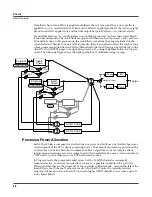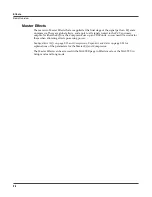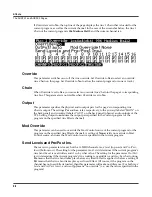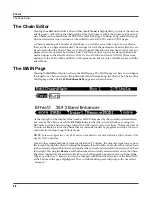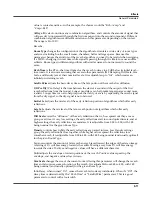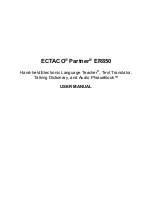
9-16
Effects
Chorus
Gate Time
is the time that the gate will stay open after the sidechain signal reaches the
Threshold. Its range is 0 to 3000ms.
Ducking
reverses the action of the gate. Normally this if set to “Off”, and the gate opens when
the input signal rises above the threshold. But when this is “On”, the gate
closes
when the input
signal rises above the threshold.
Atk
(Attack)
Time
is the time for the gate to ramp from closed to open (reverse if Ducking is on)
after the signal rises above threshold, adjustable from 0.0 to 228.0 ms.
Rel
(ease)
Time
is the time for the gate to ramp from open to closed (reverse if Ducking is on)
after the gate timer has elapsed, adjustable from 0 to 3000 ms.
Super Gate
Super Gate is a more sophisticated gate that includes these two functions:
Env Time
is the amount of time it takes for the sidechain signal envelope to drop below the
threshold. If this time is too short, the gate can close and open too quickly from amplitude
modulation in the sidechain signal. If it is too long, the gate may stay closed until the envelope
has a chance to fall, and some signals would not get through. This parameter is only in effect
when
Retrigger
is Off.
Retrigger
determines whether the gate timer will reset itself each time the sidechain signal goes
above the threshold. If it is “On”, the timer resets itself, and therefore the gate stays open as long
as the signal is above the threshold, or keeps going above the threshold, within the interval
specified by
Gate Time
. If it is “Off”, the gate closes down after
Env Time
has elapsed,
regardless off the sidechain level, and the sidechain level must fall below the threshold and
come back up again before the gate will open again.
Chorus
Chorus is an effect which gives the illusion of multiple voices playing in unison. The effect is
achieved by detuning copies of the original signal and summing the detuned copies back with
the original. Low frequency oscillators (LFOs) are used to modulate the positions of output taps
from a delay line. The movement of the taps causes the pitch of the signal to shift up and down,
producing the required detuning.
The choruses are available as stereo or dual mono. The stereo choruses have the parameters for
the left and right channels ganged, while the dual mono choruses have separate left and right
controls.
Fdbk Level
is the level of the feedback signal from the LFO1 delay tap into the delay line.
Negative values polarity-invert the feedback signal.
Tap Lvl
sets the levels of the LFO-modulated delay taps. Negative values polarity-invert the
signal. Setting any tap level to 0% turns it off.
Tap Pan
sets the stereo position for a given tap’s output. The range is -100% for fully left, to
100% for fully right.
LFO Rate
sets the speed of modulation of the delay lines with a range of 0.01 to 10 Hz.
LFO Dpth
sets the maximum detuning depth of the LFO-modulated delay lines, with a range
from 0 to 50 cents (= 1/2 semitone).
Tap Dly
adds extra delay in front of the LFO modulated delay taps from 0 to 230 ms.
Summary of Contents for PC3
Page 24: ...1 6 Introduction Options ...
Page 50: ...4 4 The Operating Modes Using the Modes ...
Page 174: ...7 54 Setup Mode The Utility Soft Buttons ...
Page 178: ...8 4 Quick Access Mode Making Your Own QA Banks ...
Page 204: ...9 26 Effects Mono Algorithms ...
Page 266: ...A 2 MIDI Implementation Chart ...
Page 308: ...Index x ...

